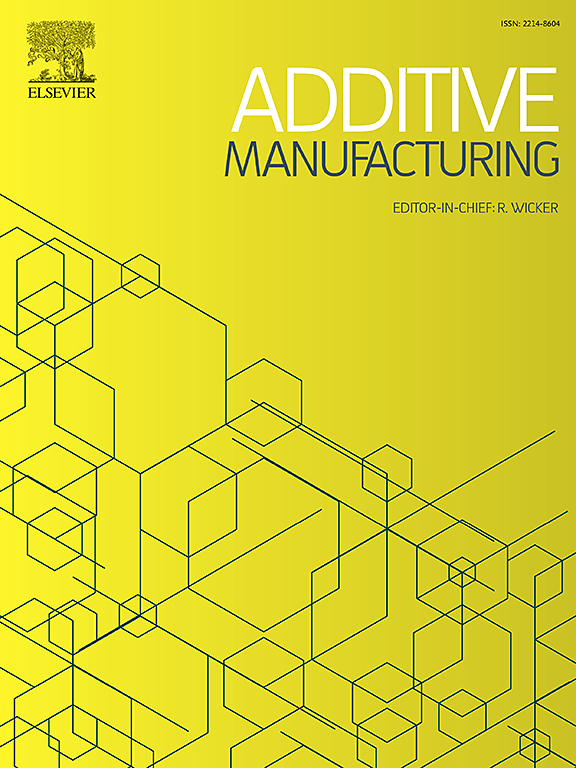激光增材制造金属基金刚石复合材料中相变诱导膨胀的残余应力消除
IF 11.1
1区 工程技术
Q1 ENGINEERING, MANUFACTURING
引用次数: 0
摘要
虽然激光粉末床熔融(LPBF)已经成为制造几何形状复杂的金属基体-金刚石复合材料的一种革命性方法,但这些组件的界面完整性受到快速热循环和金刚石增强剂与金属粘合剂之间严重热膨胀不匹配所产生的残余应力的严重破坏。由于热应变补偿的固有局限性,现有的缓解策略(包括工艺参数优化、延性相结合和梯度CTE过渡层)无法消除界面微裂纹。在此,我们提出了一种相变驱动的应力消除策略,通过在CuSn10基体内的金刚石颗粒上设计W/Co双层涂层。钨中间层通过碳化物结合和热缓冲确保界面完整性,而钴中间层在LPBF热循环过程中利用HCP→FCC相变产生补偿性体积膨胀,有效抵消热收缩引起的残余应力。W-Co涂层金刚石/CuSn10复合材料的抗弯强度为159 MPa(比Ti-Cu涂层高90 %),摩擦系数为0.25,在循环磨损下完全抑制了界面开裂。多尺度表征表明,共诱导孪晶和动态再结晶协同增强了界面韧性,而分子动力学模拟通过晶格失配分析定量验证了应力中和机制。这项工作为mmc中残余应力调节建立了一种变革性的“膨胀补偿”范式,推进了高应力增材制造应用的抗裂纹金刚石复合材料的设计。本文章由计算机程序翻译,如有差异,请以英文原文为准。
Phase transformation induced expansion for residual stress relief in laser additive manufacturing metal matrix diamond composites
While laser powder bed fusion (LPBF) has emerged as a transformative approach for fabricating geometrically intricate metal matrix-diamond composites, the interfacial integrity of these components is critically undermined by residual stress originating from rapid thermal cycling and severe thermal expansion mismatch between diamond reinforcements and metallic binders. Existing mitigation strategies—including process parameter optimization, ductile phase incorporation, and graded CTE transition layers—fail to eliminate interfacial microcracks due to inherent limitations in thermal strain compensation. Herein, we propose a phase-transformation-driven stress-relief strategy by engineering a W/Co bilayer coating on diamond particles within a CuSn10 matrix. The tungsten interlayer ensures interfacial integrity through carbide bonding and thermal buffering, while the cobalt overlayer exploits HCP→FCC phase transformation during LPBF thermal cycling to generate compensatory volumetric expansion, effectively counteracting thermal contraction-induced residual stress. The W-Co coated diamond/CuSn10 composite achieved a bending strength of 159 MPa (90 % higher than Ti-Cu coated counterparts) and a friction coefficient of 0.25, with complete suppression of interfacial cracking under cyclic wear. Multiscale characterization revealed that Co-induced twinning and dynamic recrystallization synergistically enhanced interfacial toughness, while molecular dynamics simulations quantitatively validated the stress-neutralization mechanism through lattice mismatch analysis. This work establishes a transformative "expansion-compensation" paradigm for residual stress regulation in MMCs, advancing the design of crack-resistant diamond composites for high-stress additive manufacturing applications.
求助全文
通过发布文献求助,成功后即可免费获取论文全文。
去求助
来源期刊

Additive manufacturing
Materials Science-General Materials Science
CiteScore
19.80
自引率
12.70%
发文量
648
审稿时长
35 days
期刊介绍:
Additive Manufacturing stands as a peer-reviewed journal dedicated to delivering high-quality research papers and reviews in the field of additive manufacturing, serving both academia and industry leaders. The journal's objective is to recognize the innovative essence of additive manufacturing and its diverse applications, providing a comprehensive overview of current developments and future prospects.
The transformative potential of additive manufacturing technologies in product design and manufacturing is poised to disrupt traditional approaches. In response to this paradigm shift, a distinctive and comprehensive publication outlet was essential. Additive Manufacturing fulfills this need, offering a platform for engineers, materials scientists, and practitioners across academia and various industries to document and share innovations in these evolving technologies.
 求助内容:
求助内容: 应助结果提醒方式:
应助结果提醒方式:


